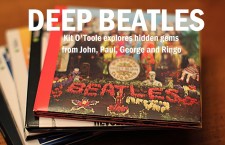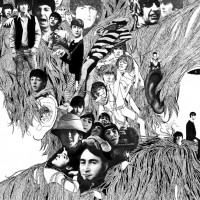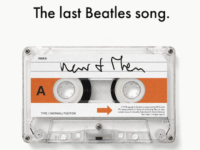Every one knows “Hey Jude,” “Yesterday,” “She Loves You.” To the point where you could (gulp!) start getting sick of them. Blame classic-rock radio, blame Cirque du Soleil, blame your older brother. The fact is, some of these things have been played to death.
But some haven’t. Where to start, though? After all, there’s a looming series of anniversary events planned to celebrate the 50th anniversary of the Fab Four’s arrival on American shores. Time’s of the essence.
Something Else! is here to help, with a quick run through 10 often lesser-heard tracks that will help rekindle even the most jaded listeners’ flickering flame of fandom …
“MARTHA, MY DEAR,”
(THE BEATLES, 1968):
S. VICTOR AARON: The whole English sheepdog thing certainly adds to the appearance of this being filler. But when viewed with the benefit of hindsight, it is his Beatles song that most anticipated the kind of pop he had a great deal of success making with his seventies band Wings. Which means, as with his Wings best, it’s a tightly constructed melody that’s catchy as hell. If he had chosen to re-record the song during the Denny Laine days with a little more production added to it, he would have easily had another hit on his hands.
NICK DERISO: Confectionary, sure, yet somehow unforgettable. I listen, each time, in wonder — thinking: McCartney can write a song about his flipping dog, and I like it.
“I ME MINE,”
(LET IT BE, 1970):
S. VICTOR AARON: Phil also gets props for picking out the best take, which was only a minute and a half long, and deftly stretching it to full-song length. Even this song-lengthening edit survived the de-Spectorization that occurred for 2003’s Let It Be…Naked. George Harrison lashes out at the mighty human ego on “Mine,” which is in a way an ironic counter-point to “Taxman” (tackled below).
NICK DERISO: Yep. That’s one of Harrison’s favorite subjects: How we’re all really bastards, deep down. This is also the last song the Beatles recorded prior to breakup, and in the same configuration as their mid-1990s “reunion” — without John Lennon.
“GOOD DAY SUNSHINE,”
(REVOLVER, 1966):
NICK DERISO: Deep, indeed. There’s the rolling piano signature, that gauntlet-tossing finish (match that, Beach Boys!), and a lyric made for days when the weather is nice enough to roll down your windows and drive a bit.
S. VICTOR AARON: The harmonies belting out the title really make this song special. Paul goes high while John handles the low notes. This unabashedly happy-go-lucky tune is one of the earlier instances where McCartney draws more from the music of his parents’ generation than his own for inspiration. He would go overboard with that later but for now, his mojo is working.
“MOTHER NATURE’S SON,”
(THE BEATLES, 1968):
NICK DERISO: Think about what follows this song on The White Album: a song about a monkey, a song about a roller coaster (or, the clarion call of end times; who knew?), the oh-so-appropriately titled “Long, Long, Long,” a vaudeville tune, a song about a dessert treat, several minutes of noise loops and a nighty-night lullaby. I guess it’s no surprise that approachable songs like “Mother Nature’s Son” get so often ignored.
S. VICTOR AARON: This is a very simply constructed; as a teenager playing mediocre guitar, I was able to self teach myself the song rather easily. But Paul’s straightforward folk hymn had simple beauty to match; it flowed out naturally and George Martin’s orchestral arrangements that gently nudge their way into the song on the second verse provide just the right amount of heft without needlessly weighing it down.
“HEY BULLDOG,”
(YELLOW SUBMARINE, 1969):
NICK DERISO: As they howl, moan and bark their way through a rollicking little aside, you remember not just what made these two remarkably listenable rock composers — but also what made Lennon and McCartney friends.
S. VICTOR AARON: Pay close attention to George, too. Consistent with the relaxed mood prevelent during the February 1968 mini-sessions, Harrison reels off a loose, jangly solo characteristic of his knack for providing not the most flashy guitar work, but the one that fits the song just right. He was like having a crack session guitarist inside the band.
“TAXMAN,”
(REVOLVER, 1966):
S. VICTOR AARON: George’s anticipatory count off to begin the <>Revolver LP grabs the listener even before meaty power chords that shortly follow do. What’s more notable are his lyrics: a direct attack on the British government for it’s confiscatory tax policies. Political songs in rock music were still just getting started in 1966, and “Taxman” remains one of more ornery examples compared to the many that appeared over the following years. Sending young men to die at Vietman was outrageous enough, but hell hath no fury like taxing a man to death.
NICK DERISO: George was always good for a nasty putdown song, an impulse that would nicely balance his tendency toward hugs-and-Hari Krishna tunes later in life. This was one he got completely right. Now, that praise is tempered by the oft-told rumor that George used the theme song from “Batman,” a favorite TV show of his in the 1960s, as inspiration for the melody. (Holy kitsch, Batman!) And that Paul did the guitar work. And that Lennon also helped with the lyics. (You can really see his fingerprint on the lyrics matching car/street, sit/seat, cold/heat and walk/feet.) Wait, what exactly did George do on this one, again?
“IT’S GETTING BETTER,”
(SGT. PEPPER’S LONELY HEARTS CLUB BAND, 1967):
NICK DERISO: I relish Lennon’s drive-by cynicism on fluffy little tracks like this from McCartney. Paul, as he often will, threatens to drift away while the soaring chorus builds behind him. But no sooner does he sing “it’s getting better all the time,” then we have Lennon dropping anchor: “Can’t get no worse.” Great guitar riff, too.
S. VICTOR AARON: Musically, it’s milking a single chord for all it’s worth. Lyrically, it’s as Nick noted, an example of the dichotomy of the sunny outlook of Paul and the skepticism of John. And like a brief afternoon thunderstorm popping up to spoil a perfect day, George swoops in with a tamboura while Lennon — via the lyrics — plainly alludes to his women-beating days, before Paul’s eternal optimism breaks up the clouds again. That “magic” chord gets really pervasive at the end, courtesy of George Martin striking the strings inside a piano. Paul’s cheerfulness wins the battle, but John’s counterpoint makes that battle so much more interesting.
“NO REPLY,”
(BEATLES FOR SALE, 1964):
NICK DERISO: John settles into this low rumbling tone that so completely captures the mood of a scorned lover — then builds to an anguished cry (“I saw the light” becomes “I nearly DIED”) in an early glimpse of the pain that, up until this point, had been largely obscured by first-blush imagery involving hairstyle and yeah-yeah-yeahs. “No Reply” was an initial step down a path of personal revelation and unbridled honesty that would find its creative and artistic peak in Lennon’s first solo release five years later. John reportedly wanted to sing the high harmony, handled here by McCartney, but couldn’t coax his voice there because of wear and tear from the band’s then-excessive touring schedule. “No Reply,” a dark and special triumph, was better for it.
S. VICTOR AARON: Lennon had one of the best singing voices in all of rock ‘n’ roll. And I think it’s mainly due to his unmatched ability to naturally project scorn, frustration, anger and pessimism. Real rock ‘n’ roll often has those qualities, after all. That wonderfully ragged throat is on full display on “No Reply.” Lennon’s attitude comes across so effectively, you’d hardly notice that it’s a rock song played with acoustic guitars, an acoustic piano and a slightly Latin beat.
“YOU NEVER GIVE ME YOUR MONEY,”
(ABBEY ROAD, 1969):
S. VICTOR AARON: Paul begins with a piano stating a melodic line, before transitioning over to a more up-tempo rhythm and mood that finds him singing much like he did for “Lady Madonna.” And then after some tasty lead guitar work by George during a second transition, the song enters the “sweet dreams” section. I suppose it sounds like a pasting together of three seemingly unrelated fragments, but it works because all of them are catchy — and the harmony/backing vocals throughout are first rate; nearly as good as the rich vocals that graced Lennon’s “Because” right before it.
NICK DERISO: Of course, this mash-up idea would eventually become ragged and tired. (Red Rose Speedway, I’m looking at you.) Still, none of that can tarnish “You Never Give Me Your Money.” When I only have time for a moment with Abbey Road, you’ll find me here, enveloped in a towering achievement that manages to fit in the personality, verve and specificity of each band member — even while deftly recognizing, by the final repeated chorus, both the hopeful optimism and crashing cynicism of the 1960s. I know, that’s a lot. It’s all in there. “You Never Give Me Your Money,” to me, is the last best thing this group ever did.
“DEAR PRUDENCE,”
(THE BEATLES, 1968):
S. VICTOR AARON: After their nasty breakup, Lennon often mocked Paul’s tendency toward ballads, but John was just as capable of pouring syrup as his erstwhile songwriting partner — even though there was usually a twist: Check out the sublime descending chord progression here. The backing vocals are just a tad creepy, too — creepy enough to tell you that this is Lennon’s song, not McCartney’s. Macca did provide a mighty sweet looping bass line, as well as the drums, since Ringo Starr had briefly quit the band.
NICK DERISO: This is one of my favorite Beatles songs and, when pressed, I can’t always make its case. After all, Lennon showed he could out-McCartney McCartney with these lyrics: The sun is up, the sky is blue — it’s beautiful, and so are you. In the end, I guess I’m sold on its simple beauty, since Lennon didn’t often allow himself to express such open-hearted emotion. As such, it’s easy to get lost in this moment. I never want this tune’s unbridled charm — or, yeah, that bassline — to end.
- Ernesto Cervini’s Turboprop, “When I Fall” (2024): Video premiere - March 15, 2024
- Disaster Pony,“Dead Neon & The Noon Sun” from ‘Disaster Pony’ (2024): Video premiere - February 27, 2024
- Christopher Hoffman, “Farewell Forever” from ‘Vision Is The Identity’ (2024): Streaming premiere - February 19, 2024




